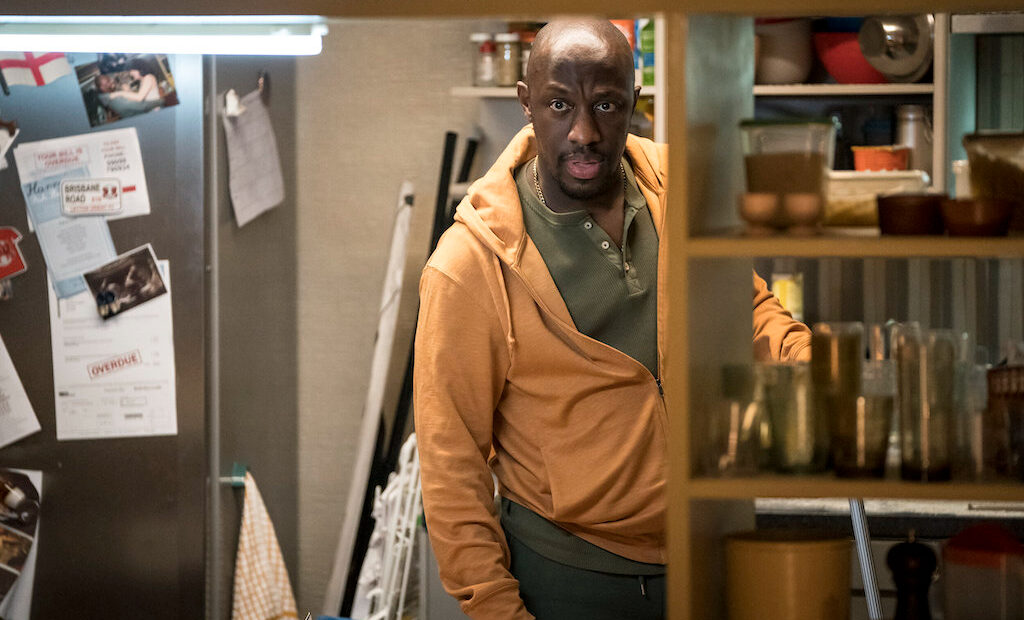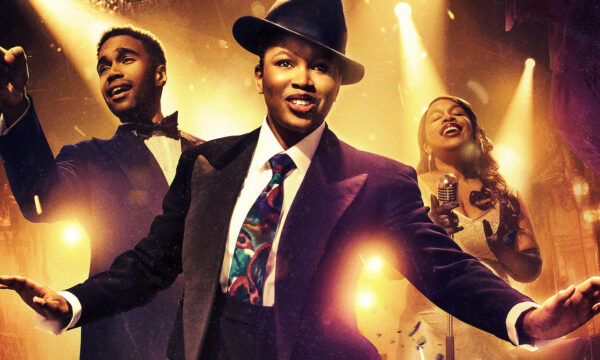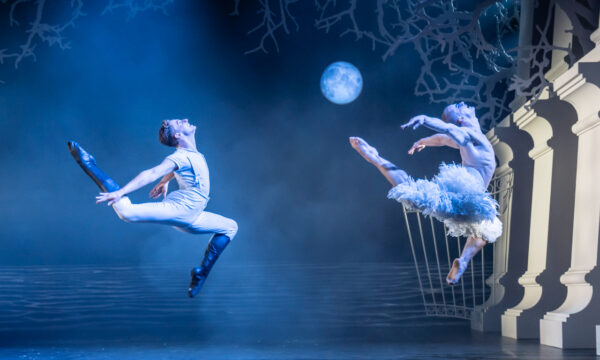Death of England: A look behind the scenes at NT’s Lyttleton Theatre and the making of Face to Face

Following the successful stage productions Death of England and Death of England: Delroy, Clint Dyer and Roy Williams have now created a special third instalment that will be broadcast on Sky Arts and shown in selected cinemas from 25th November 2021. The most distinctive and exciting feature of this new project is that it is an original film for TV, shot entirely at the National Theatre’s Lyttelton, blending emotionally charged theatricality with a slick, cinematic style and the immediacy of a television production. The National previously produced the feature film Romeo and Juliet, but that was a more straightforward case of a theatre play being filmed, whereas Death of England: Face to Face really blurs the lines between mediums, resulting in a dynamic and rare hybrid.
The first play, Death of England, opened at the National Theatre’s Dorfman in January 2020. Rafe Spall played Michael, a White British man attending his father’s funeral and coming to terms, in the post-Brexit climate, with the fact that his departed parent was racist. Later that year, in October 2020, Death of England: Delroy opened at the Olivier. Another one-man show, it starred Michael Balogun as Delroy, a Black British man and Michael’s best friend, relating his experiences in light of the Black Lives Matter movement.
The third part of the saga brings the two characters from the previous segments together in one room. Delroy is played by Giles Terera (Hamilton, Flack) and Michael by Neil Maskell (Peaky Blinders, Small Axe). Delory is in a relationship with Michael’s sister, but they are going through a rocky patch. The couple have just welcomed a baby daughter but, due to lockdown and other troubles, Delroy is unable to meet her. Michael decides to bring his niece over to her father, and the two men begin a conversation laden with memories and affection, but also with resentment and confrontation, as they take care of the infant.
For a number of weeks earlier this year, the Lyttelton Theatre was turned into a film set. The Upcoming went behind the scenes to see the impressive transformation of the space, and spoke with the creative team who put the ambitious project together. Producer David Sabel explained that the lockdown pushed them in favour of a filmed drama, but that the absence of an audience was a challenge to be overcome. The National Theatre has been offering theatregoers the chance to enjoy their productions from afar since 2009 through the NT Live programme, by streaming their biggest events live around the world. The difference this time, Sabel said, is that, “NT Live is all about capturing the sense of a live event, with an audience. To just stage something in an empty auditorium felt like it was only going to be a reminder of the thing we were all missing. We wanted to take the opportunity to use this space to innovate and think in different ways. The production starts in a world which is very real and naturalistic and it looks exactly like a film set, but then it deconstructs as we go into the characters’ heads. We celebrate theatre through the storytelling and through the language, but the aim is to get the best of both film and theatre and bring them together.”
The initial idea was to film the two existing Death of England productions, but the more the team discussed the project, the more they felt that they wanted to create something that would be specifically suited to film, and they wanted it to be a response to current events – just like the first play was a reaction to Brexit and the second to the pandemic and the BLM movement. “This one brings it up to date,” adds David, “but it does stand alone, you don’t have to have seen the previous two. I mean, your experience would be enriched if you did, because you’re seeing this growing universe of the characters, but you can also just come and meet them for the first time in this piece. It’s very special this world they create; it’s of an episodic nature, which is very unusual for a play and it’s almost like television in that respect.”
Walking around the National Theatre, one can see the crossover of mediums reflected in every department. For instance, designer Sam Harley, who comes from a television and film background, worked alongside the group who had previously created the costumes and props of the Death of England plays. We spoke to the team as they folded baby clothes for the set. They explained that having the combined expertise of film and theatre made their work run very smoothly, whether it was selecting colour palettes or working out logistics behind the use and placement of each prop. “This is a unique format,” Sam said, “but the main premise is the same: you’re telling a story and building a little world that the characters live in.”
Director and co-writer Clint Dyer told us that making these productions felt radical: “The audience’s reaction was secondary to the fact that we actually made it and people were prepared to listen to it”. He added that he, together with Roy Williams, wanted to capture the complexity of racism and “to talk about the subject via people who have love for each other, as opposed to hate – that way we could dig into the nuanced and really heartbreaking scenarios”. He believes that grey area “hasn’t been articulated because it’s more dramatic if people just beat each other up. We’re very accustomed to tropes in Black narratives, so we’re always trying to find the best vehicle to have the full conversation. We’re lacking clarity on the width of the conversation. We never see reflections of this kind of story, we only see stories of hatred and abuse.” This multidimensional approach makes the story convincing, and the production will likely attract a large audience as it raises many pertinent issues as well as being dramatically engaging. And, very importantly, it will also be accessible. “The reason we’re so thrilled about partnering with Sky Arts,” David Sabel told us, “is that the channel is now free to air, so you don’t need a Sky subscription to watch it. The National is always concerned with getting the work out to as many people as possible.”
We asked Sabel if he thinks there is a future for this theatre-cinema-television hybrid, beyond the necessity of using alternative mediums during the pandemic, and he believes there is. “There’s been so much crossover of talent,” he states, “even conventional television has become more theatrical and drawing from talent who started in theatre. We all hope that theatres will go back to being theatres and there’s always a sacred place for that, but even when we started NT Live we saw that it didn’t take away from people’s experience, it just added to it and more people had the chance to see it. It also offered educational and access opportunities. Creatively, theatres are going to be really interested in how to create a longer legacy for shows. So, even as we get back to live theatre, I think more experimentation and opportunities will come from this.”
Beyond its unique mode of storytelling, Death of England: Face to Face will be appreciated for its powerful content. It will likely instigate interesting conversations post-viewing, and spark debates in many a household. Creative, current and satisfying, it ticks every box of what the performing arts should provide.
Mersa Auda
Death of England: Face to Face from NT is available to stream via Sky Arts from 25th November 2021 and released in select cinemas. For further information visit the theatre’s website here.
Read our review of Death of England: Face to Face here.
Watch a trailer for the production here:


















Facebook
Twitter
Instagram
YouTube
RSS